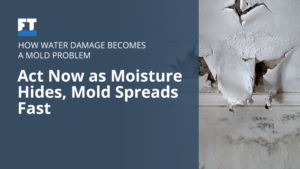The average water damage insurance claim is about $10,000, and homeowners should know that their insurance company might not cover the cost. While coverage varies, most policies only cover spontaneous water damage — not leaks.
That’s just one good reason homeowners should always look for signs of water damage. A denied claim could leave you on the hook for thousands of dollars in repairs, not to mention that unchecked water damage can also be a serious health hazard.
Thankfully, it’s easy to tell when your home has water damage. Call a water damage specialist if you discover any of the following warning signs.
1. High Humidity or Dampness
Does your home ever seem cold, damp, or clammy? High humidity often indicates that water has infiltrated your property. This is especially true if your heating system struggles to keep everything warm.
Since water absorbs heat when it evaporates, it might take a significant amount of effort to heat your home. The evaporated water then lingers in the air and makes everything feel dank.
High humidity alone is nothing to fear, although it can lead to mold growth. However, if the damp sensation lingers over multiple days, it’s possible you have water damage in your home.
2. Unpleasant Odors
Since home odors change slowly over time, they aren’t easy to notice. Give your nose a break in a new environment. When you come home from work, pay attention to your home’s scent.
If you notice an earthy or musty aroma, there’s a good chance your home has water damage. What you’re smelling is mold or mildew, a common sign that your home is too wet.
Spraying vinegar around the house may kill the mold, but it’s a temporary fix for a much larger problem. You must eliminate the water hiding in your home before you can stop the mold from coming back.
3. Clear Signs of Water Damage: Mold and Discoloration
Mold is a fungus that requires a moist environment to thrive and grow. If your home is damp enough for mold to make an appearance, then you likely have a water problem in your home. Some types of mold don’t have an odor, which is why you should also keep an eye out for it.
If you’ve ever wondered how to identify water damage, the secret is to look for brown and yellow stains. These might appear on walls, ceilings, and floors. Although mold is unsightly, it helps by marking the source of the leak.
Mold poses serious health risks. Do not interact with mold without the help of restoration professionals.
4. Excessive Water Bills
It’s always a good idea to keep track of your bills from month to month. One such reason is to look for irregularities. A significant change in your water bill could point to a plumbing issue.
Since bills can fluctuate, don’t fret about minor ups and downs. But if your water consumption has remained constant and your bill is much higher than normal, you may have a problem on your hands.
Does something seem off? Perform an audit of your home’s plumbing. Check all visible pipes and appliances such as toilets, sinks, and showerheads.
You should also know how to identify water damage. Remember: Brown discolorations are a clear indicator that you’re dealing with a leak.
5. Distended Ceilings
The most obvious sign of water damage is a distended ceiling. This occurs when water leaks from above. With nowhere else to go, water will seep into the drywall and paint and cause the ceiling to distend.
If left unchecked, the pocket of water will continue to grow until it bursts.
You can find the culprit by heading upstairs, directly above the distended ceiling. Odds are you’ll discover a sink or toilet rests above the water damage. If you don’t have a second floor, then your roof or gutters are likely at fault.
6. Warped Floors
Do your floorboards creak? Over time, water will cause wood flooring to swell. This will lead to uneven floors that may appear bent or warped.
More serious and long-term leaks will cause subtle discolorations. Rather than brown stains, such as in drywall, wood darkens in the affected areas. This can look something like a coffee stain.
Don’t have wooden floors? Thankfully, it’s easy to notice water damage in carpeting since it retains water. If you notice a wet and spongy area in your carpet, a leak may be hidden underneath.
7. Dripping Sounds
You may hear a leak before you see it. If you hear something dripping behind a wall or in the basement, it’s a good idea to locate the source. This can help you prevent a new leak from growing into an expensive and serious problem.
Keep in mind that dripping sounds aren’t unusual in a functioning plumbing system. Water damage may also occur when water quietly seeps into your home rather than dripping into it. Still, it’s a good idea to remain mindful of any changes in sound.
If you hear dripping in a place you can’t reach, that doesn’t mean it’s time to break down the wall. Just keep an eye on it for any other signs of water damage, such as dampness or discoloration.
Have You Found Signs of Water Damage in Your Home?
Nobody likes dealing with home repairs. However, water damage won’t take care of itself. It’s best to call in the professionals as soon as possible to limit the extent of the damage and cost of repair.
If you find signs of water damage in your home, don’t wait. Contact us for a free water damage evaluation any day of the year.








